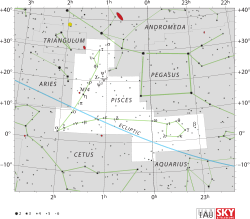Alpha Piscium
 | |
| Observation data Epoch J2000.0 Equinox J2000.0 (ICRS) | |
|---|---|
| Constellation | Pisces |
| Right ascension | 02h 02m 02.81972s[1] |
| Declination | +02° 45′ 49.5410″[1] |
| Apparent magnitude (V) | 3.82 (4.33 + 5.23)[2] |
| Characteristics | |
| Spectral type | kA0hA7 Sr + kA2hF2mF2 (IV)[3] |
| Astrometry | |
| Proper motion (μ) | RA: +32.45[1] mas/yr Dec.: +0.04[1] mas/yr |
| Parallax (π) | 21.66 ± 1.06[1] mas |
| Distance | 151 ± 7 ly (46 ± 2 pc) |
| Absolute magnitude (MV) | +0.50[4] |
| Orbit[5] | |
| Period (P) | 3267.4 yr |
| Semi-major axis (a) | 7.4″ |
| Eccentricity (e) | 0.465 |
| Inclination (i) | 113.4° |
| Longitude of the node (Ω) | 3.70° |
| Periastron epoch (T) | 2188.6 |
| Argument of periastron (ω) (secondary) | 147.9° |
| Details | |
| α Psc A | |
| Rotational velocity (v sin i) | 81[6] km/s |
| α Psc B | |
| Rotational velocity (v sin i) | 84[6] km/s |
| Other designations | |
| α Psc A: HD 12447, HR 596[8] | |
| α Psc B: HD 12446, HR 595[9] | |
| Database references | |
| SIMBAD | α Psc |
| α Psc A | |
| α Psc B | |
Alpha Piscium (α Piscium) is a binary star[5] system in the equatorial constellation of Pisces. Based upon parallax measurements made by the Hipparcos spacecraft, it is located approximately 311 light-years from the Sun.
The two components are designated Alpha Piscium A (also named Alrescha[10]) and B.
Nomenclature
α Piscium (Latinised to Alpha Piscium) is the star's Bayer designation. The designations of the two components as Alpha Piscium A and B derive from the convention used by the Washington Multiplicity Catalog (WMC) for multiple star systems, and adopted by the International Astronomical Union (IAU).[11]
The system bore the traditional name Alrescha (alternatively Al Rescha, Alrischa, Alrisha) derived from the Arabic الرشآء al-rišā’ "the well rope" and less commonly Kaitain and Okda, the latter from the Arabic عقدة ‘uqdah "knot".[12] In 2016, the International Astronomical Union organized a Working Group on Star Names (WGSN)[13] to catalog and standardize proper names for stars. The WGSN approved the name Alrescha for the component Alpha Piscium A on 21 August 2016 and it is now so included in the List of IAU-approved Star Names.[10]
In Chinese, 外屏 (Wài Píng), meaning Outer Fence, refers to an asterism consisting of Alpha Piscium, Delta Piscium, Epsilon Piscium, Zeta Piscium, Mu Piscium, Nu Piscium and Xi Piscium. Consequently, Alpha Piscium itself is known as 外屏七 (Wài Píng qī, English: the Seventh Star of Outer Fence).[14]
Properties
Alpha Piscium comprises a close binary with angular separation of presently 1.8" between the components. The main star or primary (Alpha Piscium A) is of magnitude +4.33 and spectral type A0p, while the companion or secondary (Alpha Piscium B) is magnitude 5.23 and belongs to spectral class A3m. The two stars take more than 700 years to orbit one another and they will make their closest approach to each other around 2060. One or both of the stars may be a spectroscopic binary as well. The stars have masses of 2.3 and 1.8 solar masses respectively and shine with a total luminosity of 31 and 12 times that of the Sun.[15]
References
- 1 2 3 4 5 van Leeuwen, F. (2007), "Validation of the new Hipparcos reduction", Astronomy and Astrophysics, 474 (2): 653–664, arXiv:0708.1752, Bibcode:2007A&A...474..653V, doi:10.1051/0004-6361:20078357.
- ↑ Cowley, A.; et al. (April 1969), "A study of the bright A stars. I. A catalogue of spectral classifications", Astronomical Journal, 74: 375–406, Bibcode:1969AJ.....74..375C, doi:10.1086/110819.
- ↑ Gray, R. O.; Garrison, R. F. (July 1989), "The Late A-Type Stars: Refined MK Classification, Confrontation with Stroemgren Photometry, and the Effects of Rotation", Astrophysical Journal Supplement, 70: 623, Bibcode:1989ApJS...70..623G, doi:10.1086/191349.
- ↑ Anderson, E.; Francis, Ch. (2012), "XHIP: An extended hipparcos compilation", Astronomy Letters, 38 (5): 331, arXiv:1108.4971, Bibcode:2012AstL...38..331A, doi:10.1134/S1063773712050015.
- 1 2 Hartkopf, W. I.; et al. (June 30, 2006), Sixth Catalog of Orbits of Visual Binary Stars, United States Naval Observatory, retrieved 2017-06-02.
- 1 2 Royer, F.; et al. (October 2002), "Rotational velocities of A-type stars in the northern hemisphere. II. Measurement of v sin i", Astronomy and Astrophysics, 393: 897–911, arXiv:astro-ph/0205255, Bibcode:2002A&A...393..897R, doi:10.1051/0004-6361:20020943.
- ↑ "alf Psc". SIMBAD. Centre de données astronomiques de Strasbourg. Retrieved 2017-08-04.
- ↑ "alf Psc A". SIMBAD. Centre de données astronomiques de Strasbourg. Retrieved 2017-08-04.
- ↑ "alf Psc B". SIMBAD. Centre de données astronomiques de Strasbourg. Retrieved 2017-08-04.
- 1 2 "Naming Stars". IAU.org. Retrieved 2 March 2018.
- ↑ Hessman, F. V.; Dhillon, V. S.; Winget, D. E.; Schreiber, M. R.; Horne, K.; Marsh, T. R.; Guenther, E.; Schwope, A.; Heber, U. (2010). "On the naming convention used for multiple star systems and extrasolar planets". arXiv:1012.0707 [astro-ph.SR].
- ↑ Allen, Richard Hinckley, Star-names and their meanings, G. E. Stechert, pp. 342−343.
- ↑ Division C WG Star Names, IAU Working Group on Star Names (WGSN), retrieved 22 May 2016.
- ↑ (in Chinese) AEEA (Activities of Exhibition and Education in Astronomy) 天文教育資訊網 2006 年 5 月 19 日
- ↑ Kaler, James B., "ALRESCHA (Alpha Piscium)", Stars, University of Illinois, retrieved 2012-04-06.